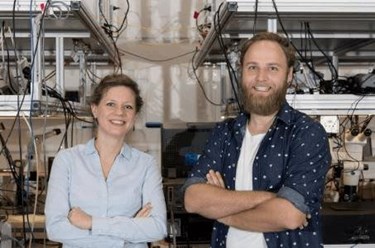Scientists Build First Photonic-Phononic Microchip
By Jof Enriquez,
Follow me on Twitter @jofenriq

Researchers at the University of Sydney (USYD) have fabricated the first photonic integrated circuit to successfully transfer information as light waves, into sound waves, and back again as light waves. This type of chip can be integrated in future generation optical communication systems to replace conventional electronic systems.
Signal processing technologies have advanced much because scientists have learned how to encode information onto photons, rather than electrons, to eliminate the risk of interference from electromagnetic radiation, and to lessen the heat generated by electronic resistance.
In order to optimize and miniaturize photonic integrated circuits further, researchers also have been trying to harness lower-velocity sound waves to store information longer in tiny spaces.
Prolonging the storage time is key in all-optical processing and light-matter interactions.
At USYD's Australian Research Council Centre of Excellence for Ultrahigh bandwidth Devices for Optical Systems (CUDOS), the microchip fabricated by Australian National University's Laser Physics Centre was able to convert incoming light waves into slower sound waves, which acted as a buffer memory that stores the information (for an extra ten nanoseconds) for later retrieval using the reverse process.
“The information in our chip in acoustic form travels at a velocity five orders of magnitude slower than in the optical domain,” said Dr. Birgit Stiller, research fellow at the University of Sydney and supervisor of the project.
“It is like the difference between thunder and lightning,” she said.
Most other researchers so far have relied on optomechanical resonator systems to induce light-sound coupling. These experiments were successful only in a narrow bandwidth, though.
The USYD group claims to have built a far more efficient device that is capable of multi-wavelength operation.
"Our system is not limited to a narrow bandwidth," said Dr. Stiller. "So unlike previous systems this allows us to store and retrieve information at multiple wavelengths simultaneously, vastly increasing the efficiency of the device."
In their experiments using their microchip, Stiller and colleagues report achieving "the storage of phase and amplitude of optical information with gigahertz bandwidth and show operation at separate wavelengths with negligible cross-talk."
"In communication networks and computing architectures, this versatility plus the continuous tunability of the storage time of up to several nanoseconds enables precise and dynamic synchronization of optical data streams between several high-speed parallel processes," they report in Nature Communications.
Moreover, the photonic-phonic memory only relies on a planar waveguide and can be integrated with other on-chip components in a straight forward manner, unlike with other optomechanical platforms investigated to date.
